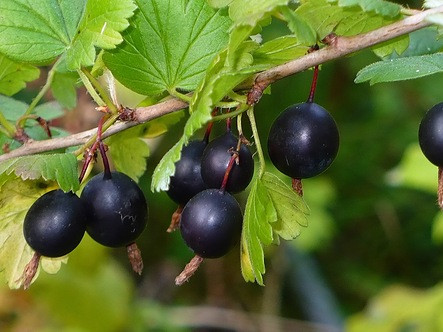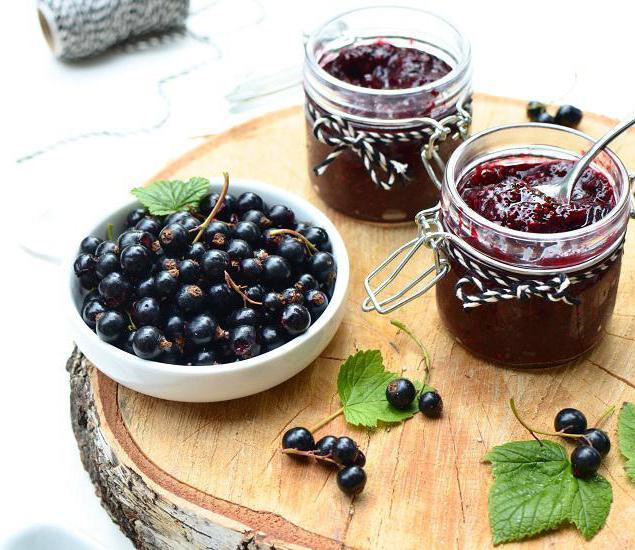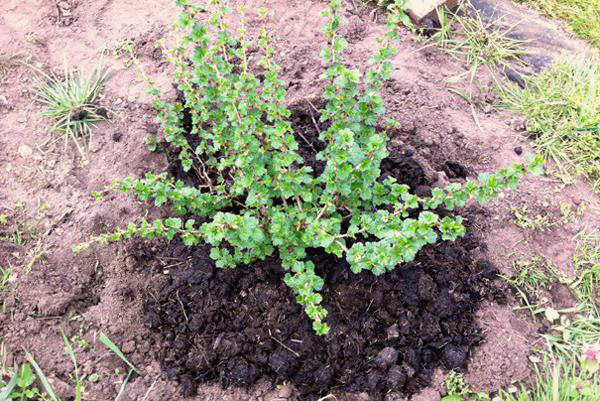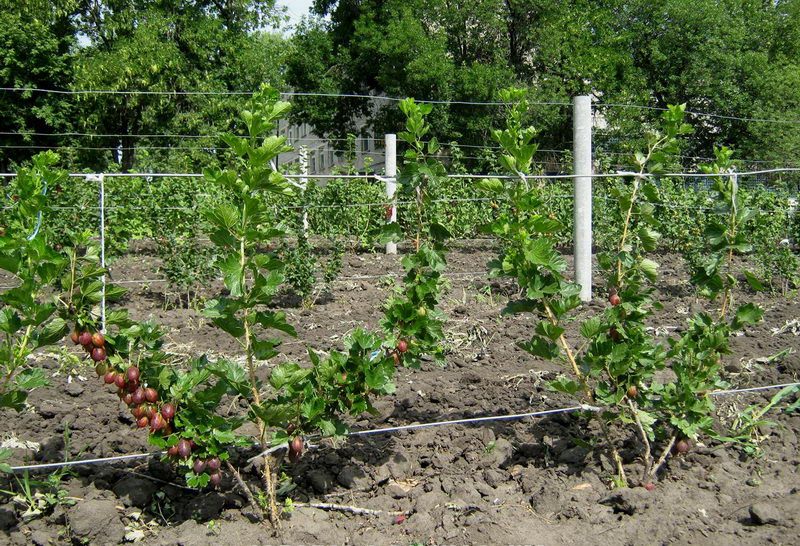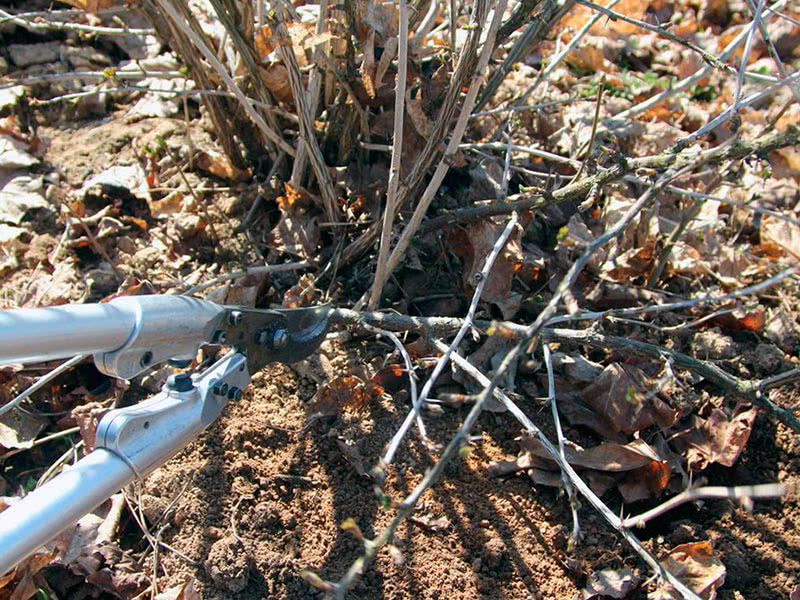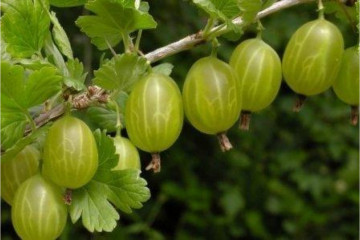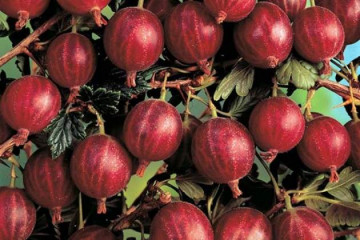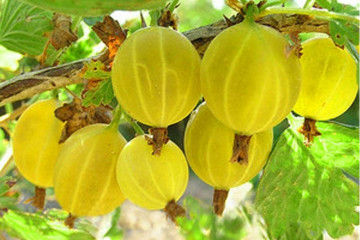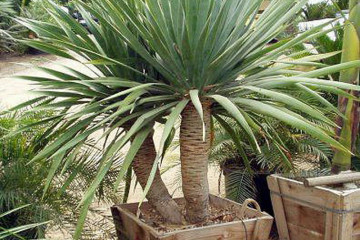Black gooseberries - growing at home
Content:
The history of the appearance of this variety began with the fact that new varieties of gooseberries were brought to the UK from America. Together with them came a disease previously unknown in Europe - powdery mildew, or spheroteka. The disease spread throughout the continent, destroying many unique local varieties, and reached Russia.
In 1920, the Russian biologist and breeder IV Michurin set himself the task of developing a variety that is resistant to disease, but at the same time has a decent taste. He crossed the European gooseberry with the American one, which is immune to the spheroteca. The breeder did not plan to issue documents for a new variety, but was going to use it to obtain new hybrids. But this black gooseberry was so fond of gardeners that the name Black Negus gained popularity.
Description of culture
Bushes of the Black Negus are powerful, spreading, can reach up to 2 m in height. A feature of this variety are the thorns (the thorn can reach a length of 2 cm), which the Negus inherited from the wild American ancestor.
Characteristics of berries
Black berries that grow on this gooseberry are unusual for this species: small, completely smooth, sometimes with a slight bluish bloom, stick well to the bush, even overripe berries do not fall off. The pulp of the Negus fruit is delicate, maroon color, the seeds are very small, the skin is thin.
Features of the variety
Black Negus gooseberry begins to bloom in May. The berries ripen all at the same time in late July - early August. During the ripening period, the shrub looks very beautiful: black berries densely cover the branches on the gooseberry, do not crack from rains and can sag until late autumn.
Taste qualities
Black negus has an unusual taste: the berries are sweet and sour, similar to Isabella grapes, they have a bright aroma inherent only in this variety.
Drought resistance and frost resistance
Since this gooseberry variety was bred in Russia, it is distinguished by frost resistance. He is not afraid of the Russian winter: neither frosts down to -25 ° C, nor spring frosts, nor cold winds, so this variety has taken root in all regions of the country.
The black negus can rightfully be called a drought-resistant plant, but the drying out of the soil affects the amount of the crop.
Disease and pest resistance
This black gooseberry has acquired immunity to diseases and pests from an American "relative". Spheroteca, rust and other fungal diseases are not able to harm him
Using berries
The bright color and original, rich taste of the fruits of the Black Negus have found their place in cooking. It is used as a food coloring, and gooseberries are also used to make various wines and liqueurs. Wine from the Black Negus has a bright grape taste and aroma, as well as a velvety wine color.
Black Negus berries contain many useful substances, and the amount of vitamin C in it is more than in ordinary gooseberries, so it is used to make juices, compotes and jams.
Advantages and disadvantages of the variety
If there is a gooseberry variety that is ideal for growing on any garden plot in any region of Russia, then this is the Black Negus gooseberry, a description of all its advantages would take up a lot of space, so below are only the most basic of them:
- wonderful taste;
- many useful substances and vitamins;
- unpretentiousness;
- frost resistance;
- disease and pest resistance;
- spectacular appearance;
- good transportability and long shelf life of fruits.
Planting young seedlings on the site
It is best to use annual seedlings, they are easier to accept, they do not need a large planting hole. Before planting, they are treated with a root-forming preparation according to the instructions. To activate the growth of the root system, before planting, the roots of the seedlings should be cut off by a couple of centimeters.
Landing time and pattern
The black negus will equally well take root in both autumn and spring planting. But if you plant a plant in the fall, then it should be borne in mind that about 1.5 months should pass from planting to the onset of frost, so that the shrub has time to adapt, and its root system is strengthened before winter.
Choosing a landing site
For planting gooseberries, you should choose a sunny and not very windy place, but for the unpretentious Black Negus variety, planting in a small shade is also possible.
The shrub should be planted on an elevated (at least flat) surface, because excess moisture is detrimental to the roots of the plant. A place where groundwater rises close to the surface is also not suitable for planting.
The composition of the soil does not really matter, the gooseberry will grow and bear fruit on any soil except clay. But in order for the plant to reveal its full potential and bear fruit abundantly, loose fertile soil, rich in organic fertilizers, is chosen for planting.
Site preparation
Before planting seedlings, it is advisable to dig up the soil and get rid of weeds with roots, because when the thorny bush grows, it will be problematic to clean up under it.
Planting process
Pits for seedlings are dug 40 cm wide and 50 cm deep, fertilizer is applied into them (humus or compost is good as a top dressing, if they are not available, then superphosphate and potassium can also be used), and water is poured. The roots of the seedling are dipped in a clay mash and lowered into a hole at a slight slope so that the root collar is covered with soil by 5 cm. After planting, the seedlings are cut off, leaving 4-6 buds on each. The seedlings are watered abundantly, it will take about 10 liters of water per bush.
Features of seasonal care
Black negus needs rare but abundant watering: 3-5 times a season up to 10-30 liters of water under the root of each shrub. If the summer is dry, then the plant should be watered more often.
Fertilize gooseberries from 1-2 years after planting. Top dressing is done 2 times a year: in the spring, until the buds have blossomed, and in the fall.
Black gooseberry is a very thorny plant, therefore, to get rid of frequent loosening and weeding, the trunks are covered with mulch.
Growing gooseberries on trellises facilitates harvesting and speeds up the ripening of the berries. The branches of the shrub are arranged in a fan, directing them upwards evenly along the surface of the trellis at a distance of about 20 cm from each other.
Spraying the shrub with an infusion of orange peels, onion peels or a solution of Baikal-EM-1 will protect it from aphids.
In early spring and on the eve of winter, the Black Negus must be cut off, all weakened branches, small shoots and non-fruiting shoots must be removed in a timely manner. For branches from 2 to 7 years old, you need to carry out anti-aging pruning. In the spring, it is advisable to shorten the top of the bush by 1/3.
To prepare the gooseberries for winter, it is enough to prune and water the plant abundantly. The amount of water on the eve of frost increases the heat capacity of the soil, and the soil freezes more slowly.
Reproduction
The Black Negus reproduces in standard ways.
- By cuttings. In autumn, young shoots are separated, cut into cuttings with 3-4 buds and planted in the ground at an angle of 45 ° so that 1-2 buds remain above the ground.
- By division. The shrub is dug up and divided into two parts. One of them is put in a new place.
- Layers. This is the most effective method of reproduction: in the spring, one of the shoots of the bush is bent to the ground and buried in it. The plant is regularly watered, and after the regrowth of new shoots, they are fed. In the fall, the new plant is separated and transplanted.
- Shoots. Prune and then root the branches that are formed close to the base of the plant. This propagation method is not suitable for bushes over 8-9 years old.
- Branches. A well-formed branch with a part of the root system is separated from the mother plant and transplanted to another place.
Pest and disease control
To protect the plant from pests in early spring, before the buds have awakened, it should be treated with hot water.
Today, breeders are developing many new varieties of berries, and usually new ones are superior to their predecessors. But there are varieties that are not subject to time, for example, the Black Negus gooseberry. And although the Negus is a gooseberry with almost a century of history and is a retro variety, its taste can give odds to many modern hybrids. Therefore, even now it remains one of the most beloved berry crops by gardeners.
